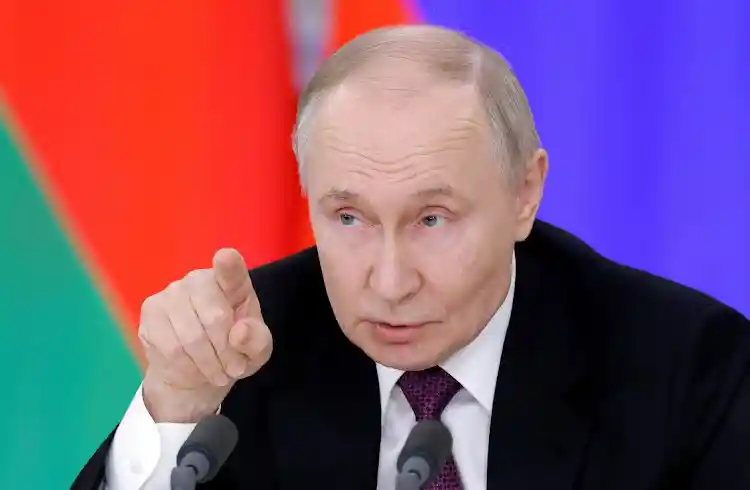Putin Sets Conditions for Ukraine Ceasefire Amid Global Diplomatic Tensions (Full List)
- Advertisement -
Russian President Vladimir Putin has responded to a 30-day ceasefire proposal for Ukraine, agreeing in principle but raising multiple concerns about its implementation. Speaking at a press conference in Moscow on Thursday, Putin emphasized that a truce must lead to a lasting peace and not be used by Ukraine for military advantage.
His remarks came after Ukrainian President Volodymyr Zelensky accused him of manipulating the ceasefire talks and called for tighter sanctions on Russia. Meanwhile, the United States has intensified restrictions on Russia’s oil, gas, and banking sectors, further increasing economic pressure on Moscow.
Putin’s Ceasefire Conditions: Key Points
- Advertisement -
Putin acknowledged that the ceasefire proposal was “right” in principle, but stated that critical questions remained:
- Guarantees on Military Activities: “How will those 30 days be used? Will Ukraine use it to mobilize, rearm, or train soldiers? How will this be controlled?”
- Monitoring Compliance: “Who will enforce the ceasefire over 2,000km of frontline territory? Who decides who has violated it?”
- Security Concerns in Kursk: Putin cited Russia’s Kursk region, where Ukrainian forces launched a military incursion last year, stating that while Russian troops had regained control, Ukrainian forces were still attempting to retreat.
“There are two options for Ukrainians in Kursk—surrender or die,” Putin declared, reinforcing his hardline stance on territorial disputes.
- Advertisement -
Zelensky’s Response: ‘Putin is Stalling’
In his nightly video address, Ukrainian President Volodymyr Zelensky dismissed Putin’s comments as deliberate obstruction.
“Putin doesn’t say no directly, but in practice, he is preparing a rejection,” Zelensky said. He accused the Russian leader of stalling by setting impossible preconditions, making negotiations difficult or impossible.
- Advertisement -
Ukraine’s position remains clear:
- A two-step process: Ukraine wants a ceasefire first, followed by negotiations for a long-term settlement.
- No compromise on sovereignty: Kyiv maintains that Russia must withdraw from occupied territories before peace talks can progress.
U.S. Reaction: Trump Calls for ‘Right Decision’ from Russia
U.S. President Donald Trump responded to Putin’s remarks, stating that he hoped Russia would “do the right thing” and accept the 30-day truce.
Speaking at the White House, Trump indicated that he had already discussed specific land agreements with Ukraine as part of a potential final settlement.
- Advertisement -
“We’ve been discussing with Ukraine land and pieces of land that would be kept and lost, and all the other elements of a final agreement,” Trump said.
His comments hint at the possibility of territorial concessions, a topic that remains highly controversial among Ukrainian officials and Western allies.
Rising Tensions: U.S. Sanctions and Russia’s Response
As diplomatic discussions continue, the U.S. has expanded sanctions on Russia, particularly targeting:
- Oil and gas exports
- Financial transactions through U.S. banking systems
- Trade access for countries buying Russian energy
In response, Putin held closed-door talks with U.S. special envoy Steve Witkoff, though details of their discussions remain undisclosed. Meanwhile, Kremlin aide Yuri Ushakov officially rejected the U.S.-led ceasefire proposal, signaling that Russia is not willing to agree under current conditions.
War at a Crossroads: What Happens Next?
The Ukraine-Russia war, now in its third year, has reached a critical juncture. Both sides are attempting to shape global narratives:
- Ukraine seeks to portray Russia as unwilling to make peace, hoping for greater international support.
- Russia is pushing for a broader deal, incorporating its long-standing demands on NATO expansion and Ukrainian sovereignty.
However, this strategic deadlock presents a major challenge for Trump, who has expressed his desire for a swift resolution to the war. Yet, with Putin showing no signs of backing down, securing a ceasefire that satisfies all parties remains a difficult task.
Editor’s Commentary.
As global powers engage in diplomatic maneuvers, the future of Ukraine’s ceasefire proposal remains uncertain. Putin’s tough conditions, Zelensky’s firm resistance, and Trump’s push for a rapid peace deal set the stage for further geopolitical tensions.
With sanctions tightening and military operations ongoing, the question remains: Will Russia and Ukraine find common ground, or is this just another chapter in a prolonged conflict?
What Do You Think?
Can a 30-day ceasefire realistically lead to lasting peace, or are both sides using it as a political tool? Share your thoughts below!
- Advertisement -


